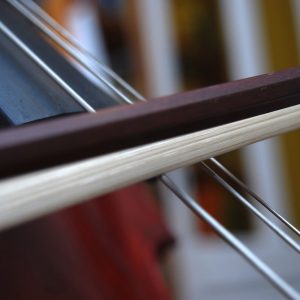- To truly differentiate between the physical sensations of ‘resting’ and ‘pressing’ the string
- To experience the extremes of letting weight down and holding weight off
- To enjoy the pulling (tugging against resistance) necessary to produce a big sound and the freedom of easy bow speed when creating light sounds
- Letting gravity take us deep inside the string creates a wonderful resistance from the string. “Resistance is your friend” and a key to a big sound. Enjoy the physicality of bow arm belonging to cello; love the tug and the pull through.
- ‘Resting down’ at the frog allows all the muscles of the arm and hand to stay soft. Let the palm of your hand soften. The fingers have cushion and act as shock absorbers; you will feel that you are under the surface and inside of the string.
- ‘Pressing down’ creates muscle tension in the bicep, forearm and fingers as the arm pushes into the string. You will not feel ‘under the surface,” you will feel that you are pushing against a wall.
- Rest, press, rest, press–experiment with both techniques until you can feel the difference between them.
- Use the ship at sea analogy to imagine boats large and small of various weights and speed. How do they sit in the water? Visualize that your bow can also sink deep or float, that it can move at any depth or speed.
- By releasing the weight of your arm into the string, you will feel the string supporting the bow; your arm can rest. This passive heaviness creates the ‘resistance’ that you must engage by pushing and pulling the bow through the string.
- A big sound requires both vertical and horizontal forces. Most of our vertical power should come from weight and gravity, allowing muscles to remain more vertically passive than active. This heaviness creates the resistance through which we pull the bow. When we are deep under the string, the primary engagement of muscle is horizontal, pulling through the resistance.
- The horizontal force can gain easy power from ‘weight shift.’ Weight shift is a whole body motion. As you draw a down bow, step on your right foot and push the body left, shifting your body in the opposite direction of the bow motion. Using weight shift to minimize active use of muscle will be discussed in an upcoming CelloBello lesson.
- Observe yourself as you practice by looking into a mirror. In the video, the differences between ‘pressing down’ and a ‘resting down’ at the frog are demonstrated.
- Resting into the string and working with the string’s natural resistance produces a clearer, more focused sound. It projects well because it is centered. Don’t let extreme resistance inhibit your music making–you can still manipulate sound and shape with infinite variety.
- Varying right arm weight not only produces changes in dynamics, it also provides an unlimited palate of colors and sound densities ranging from a deep sound under the surface of the string to a light sound suspended above it.
Cellosophy
"Renowned violin pedagogue Shirley Givens uses the same imagery in her wonderful method book “Adventures in Violinland”, Book 1C, “Meet The Bow”, available through Shar Products. Imagine that your Bow is a Ship and the Strings are an Ocean. In big playing you can feel as an ocean-liner, heavy and deep beneath the surface, pulling your boat through the resistance of the water. In soft, intimate moments, suspend your weight and feel as a toy boat lightly floating on the surface where there is no resistance at all." -Paul Katz
RECOMMENDED NEXT
RELATED BLOGS
The Most Erogenous Region of the Cello
By Stefanie Buller | 04/19/2017

